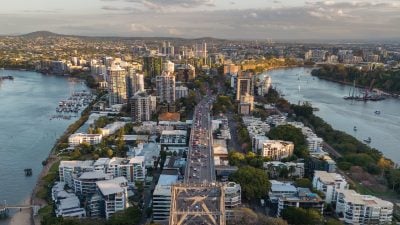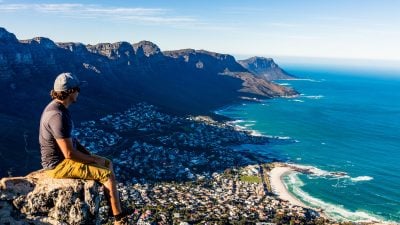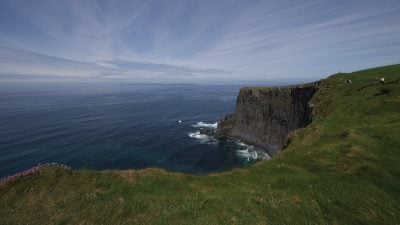
Angkor Wat at Sunrise and Other Unforgettable Sights on an Asian Vacation
With so many breathtaking feasts for the eyes in this world, here are six memorable sights to experience on an Asian vacation.
We all travel for different reasons. Some of us are foodies who love to feast on new flavours that you’ll never find at home. Some of us are adventurers, wanting to summit that mountain, cross that river, and trek across that glacier to experience the majesty of the natural world. Some of us are history buffs, venturing to historic castles, palaces, and places of worship to engage with the people that came before us and broaden our views of the world. Beyond what type of traveller we are, we also travel to see unforgettable sights that we can’t see at home.
Travel will reward you with some incredible sights, whether a temple at sunrise, a mountain towering above the horizon, or rocks jutting out of the waters of a picturesque bay. In particular, an Asian vacation offers the chance to see many breathtaking sites that are so much more vibrant than even the most gorgeous pictures online. It’s one of the oldest parts of the world and, as such, is home to sights that have been crafted over millennia. We’ve highlighted six particularly-stunning sights that you can experience on a trip to Asia. They range from temples to natural formations to breathtaking buildings and cityscapes. Some are familiar sights while others are less popular. They are by no means the full range of great views to see in Asia, but they are some of the most memorable sights you’ll experience on an Asian vacation. If you get to see one of these sights during your vacation, the entire trip will have been worth it.
Angkor Wat at sunrise
I’ve mentioned this in the title so it’s fitting that it’s the first entry on this list. Angkor Wat is the largest temple in the world and the pride and joy of Cambodia. The Cambodian people are so enamoured by it, it even adorns their flag. While the name Angkor Wat is often used to describe all the Cambodian temples north of Siem Reap, Angkor Wat is actually the name of the central temple of the larger Angkor complex, which includes Angkor Thom, Bayon, and more far-flung sites like Ta Prohm. All of these temples are spectacular and it is worth devoting several days to exploring them in their totality. But there are no sights as stunning as the main temple, Angkor Wat, at sunrise.
You’ll have to get up early to see Angkor Wat at sunrise, as the sun rises a bit before 6am on average. But the early rise is worth it as the temple transforms from a striking silhouette against a backdrop of purple-orange sky to a golden treasure awash in the first slanting lights of daybreak. You’ll share the view with other travellers, as heading to the temple at sunrise is a popular way to spend one morning on a tour here, but the presence of other people won’t distract from the grandeur. Angkor Wat is an impressive sight in any context, but in the golden light of morning, it’s truly spectacular.
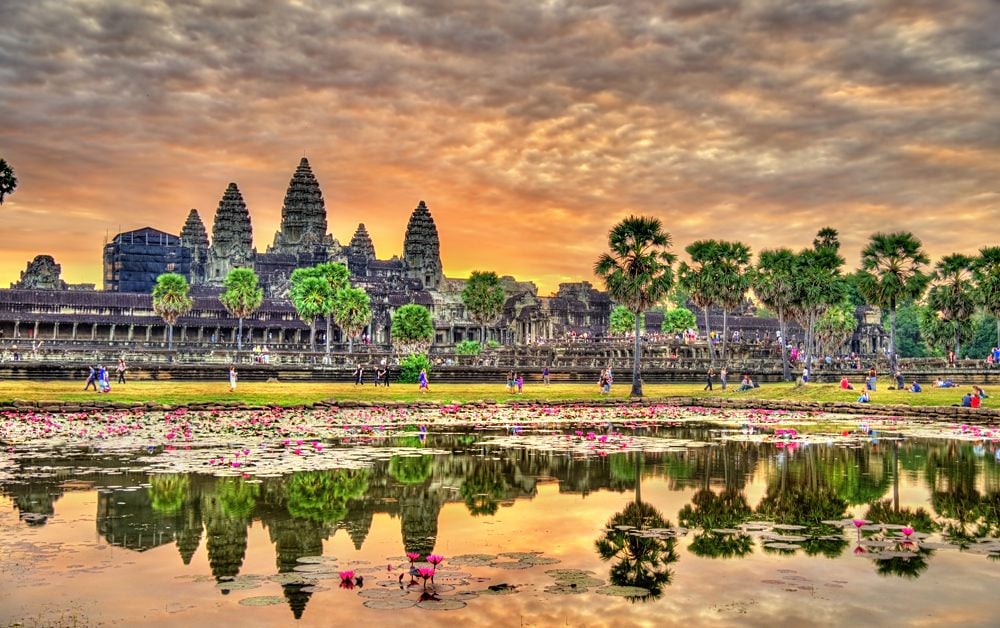
Mount Fuji from the shores of Lake Kawaguchiko
Japan’s largest mountain is one of the most iconic images in the country. You’ll find it in some of the most famous Japanese artworks, especially Hokusai’s 24 Views of Mt. Fuji, which includes the famous, “The Great Wave off Kanagawa.” You’ll see it featured in advertisements and adorning postcards and blog articles about visiting Japan on an Asian vacation. If you have to capture Japan in one image, there’s a good chance you’ll include Mt. Fuji in the image.
It’s easy to figure out why Mt. Fuji is so adored. Not only is it the tallest mountain in the nation, but it also looks like the platonic ideal of a mountain. It has symmetrical slopes and a snow-capped summit that makes it stand out from the greenery and blue sky that surrounds it. It’s likely that you’ll see Mt. Fuji at some point during a trip to Japan. I saw it from a hilltop in Gotemba during a stopover on a train trip from Osaka to Tokyo. If you sit on the right side of the shinkansen, you can spot it from the train tracks as you race across the Japanese countryside. If the sky is clear, you can even see it from the heights of the Tokyo Skytree in Sumida. However, none of these views measure up to the sight of Mt. Fuji as seen from the northern shore of Lake Kawaguchiko.
Lake Kawaguchiko lies directly to the north of Mt. Fuji. If you stand on the northern shore of the lake and face south, you’ll spot Fuji as well as its reflection in the water. If you happen to visit during the spring, you’ll see Fuji surrounded by cherry blossoms, while a visit in fall will display the landscape transformed in reds and golds. Regardless of when you visit, this is the ideal viewing spot. There is no better place to witness the iconic majesty of Japan’s most famous mountain.

Banaue Rice Terraces from a hilltop
The Banaue Rice Terraces are some of the most complex agricultural formations in the world. These cascading rice paddies in the mountainsides of the Philippines look like hills in the process of melting, as if an alien laser had blasted their summits, causing the green hillsides to melt down like a chocolate fondue fountain at a lavish wedding. Of course, the terraces aren’t the result of alien invasion, nor even modern technological innovation. The ancestors of the local indigenous peoples carved them into the mountainsides up to 2,000 years ago, possibly by hand, and the locals still use these terraces to plant rice and harvest vegetables year in and year out.
Regardless of their low-fi origin story, the Banaue Rice Terraces are stunning. They’re located on the island of Luzon, to the north of Manila, so they’re accessible. There are no bad places to view these incredible rice paddies from, but you can’t go wrong with summiting one of the hilltops to enjoy panoramic views of the countryside and the cascading terraces. From a high vantage point, you’ll be able to appreciate the depth of the terraces and the sheer number of them along the hillsides. It’s a breathtaking sight on an Asian vacation.
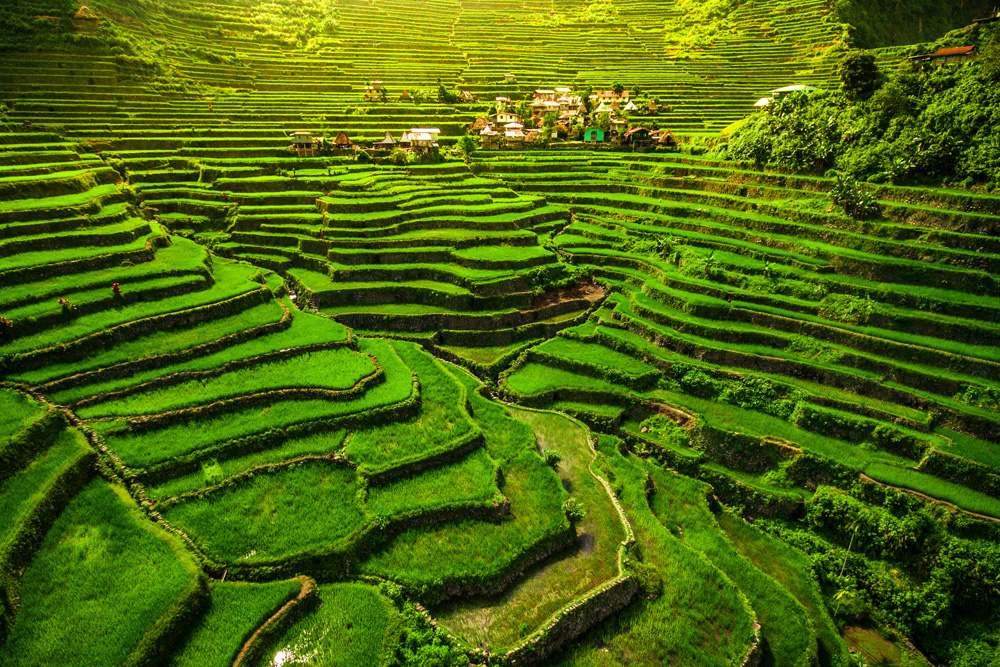
Halong Bay on the water
Found in northern Vietnam and located on the coast near Hanoi, Halong Bay is defined by its many limestone karsts rising out of the water. These rocky islands and islets have sheer cliff edges and are covered in vegetation, making it seem as if the tops of thousands of mountains are rising out of the waters around you. There are an estimated 2,000 islets within the bay and hundreds of boats head out onto the water each day to showcase them to visitors.
You can easily admire Halong Bay from the shoreline, but you best hire a junk to take you out on the water to see the limestone karsts up close. Part of the appeal of Halong Bay is that there is seemingly no end to the islets. You figure you’ve seen it all and then your boat turns a corner around a particularly-large limestone karst and all of a sudden another dozen islets have jumped into view. Having the limestone karsts surround you as you venture through the bay is an unforgettable sight. It makes you understand why people call Halong Bay the “Eighth Wonder of the World.”
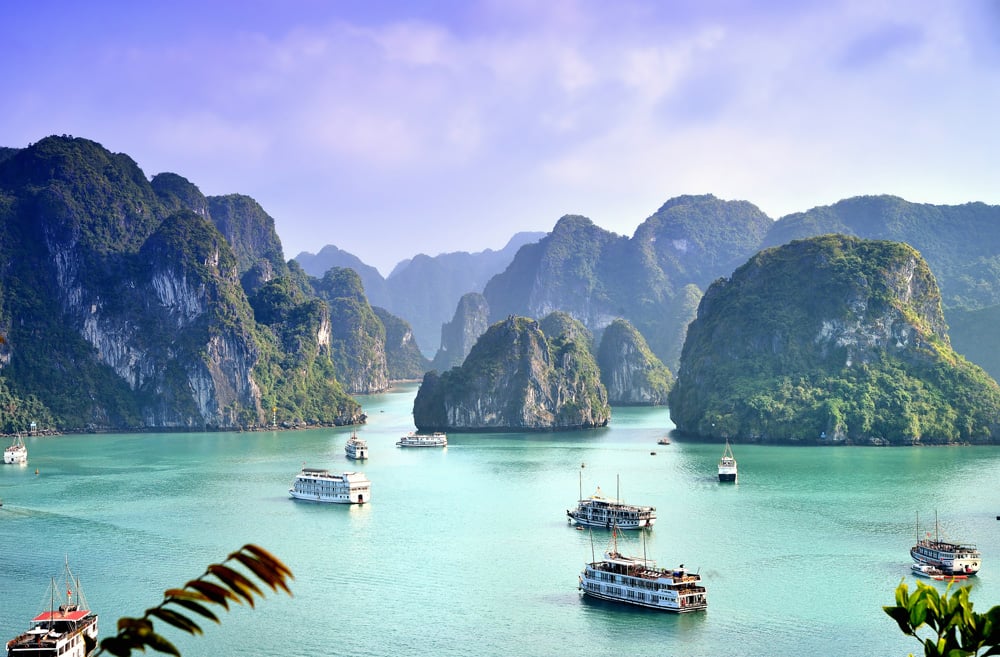
Potala Palace at sunset
The former residence of the Dalai Lama is a stunning building. Built on a hill overtop the town of Lhasa in Tibet, Potala Palace is iconic for its white stone façade and symmetrical rows of windows that dominate the town’s skyline. Prior to China’s annexation of Tibet, the palace essentially functioned as a royal residence and governmental headquarters. After the Dalai Lama fled to India during the 1959 Tibetan Uprising, the palace has served as a museum and heritage site for the Tibetan people.
Part of what makes the palace so striking is its minimalism. Its dominant colours are white and red, reflecting the snow and rock of the mountains. As well, it sits atop a hill in the centre of Lhasa, making it the natural focal point of the city. If you view it from below, the palace is stunning and massive, running 400m wide and 350m thick. But it’s the backdrop of the mountains of the Tibetan Steppe that make Potala Palace even more striking and unforgettable. It is architecturally fascinating, religiously significant, and absolutely breathtaking when viewed along with its surroundings. There are many reasons travellers visit Tibet and Lhasa on their Asian vacation, but the sight of Potala Palace against a backdrop of Tibetan mountains has to be among the foremost reasons.
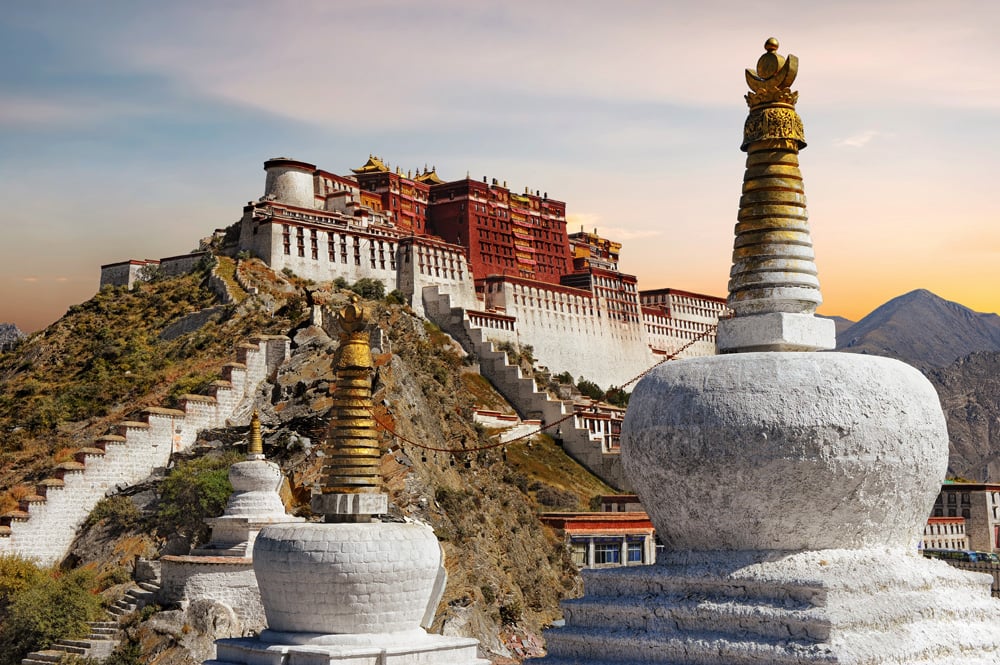
Hong Kong from Victoria Peak
Hong Kong is one of the largest and densest cities on the planet. Its skyline is defined by massive skyscrapers that skirt Victoria Harbour and cover virtually every square inch of land that isn’t mountain or water. Even people who have never been to Hong Kong are aware that is has one of the world’s most famous skylines. However, they may not be sure where the best view of said skyline exists. Some people may argue for the skyline as seen from Ozone, the trendy skyscraper bar that sits on the 118th floor of The Ritz-Carlton. Others may say that you should take a boat out onto the water to have the best view of the city’s rising towers.
Neither of these answers are wrong. They offer great views. However, climbing Victoria Peak and gazing down on Hong Kong’s skyline from above gives a great idea of just how massive this city is. Located on Hong Kong Island, Victoria Peak is a popular tourist site, with a cable car and public park that attract locals and visitors alike. Although the summit is home to a radio telecommunications tower and, thus, is closed to the public, you don’t need to get to the summit to enjoy great views of the city. You need only head to the viewing decks on Victoria Peak and gaze out over the dozens (maybe even hundreds; who’s counting!) of skyscrapers that define the city’s skyline. The Peak offers great views at all times of day, but if you head up there during the evening, you’ll experience the famous skyline lit up in all its glory. There are plenty of massive city skylines to view on adventures around the world, but few stand up to the overwhelming density of Hong Kong.
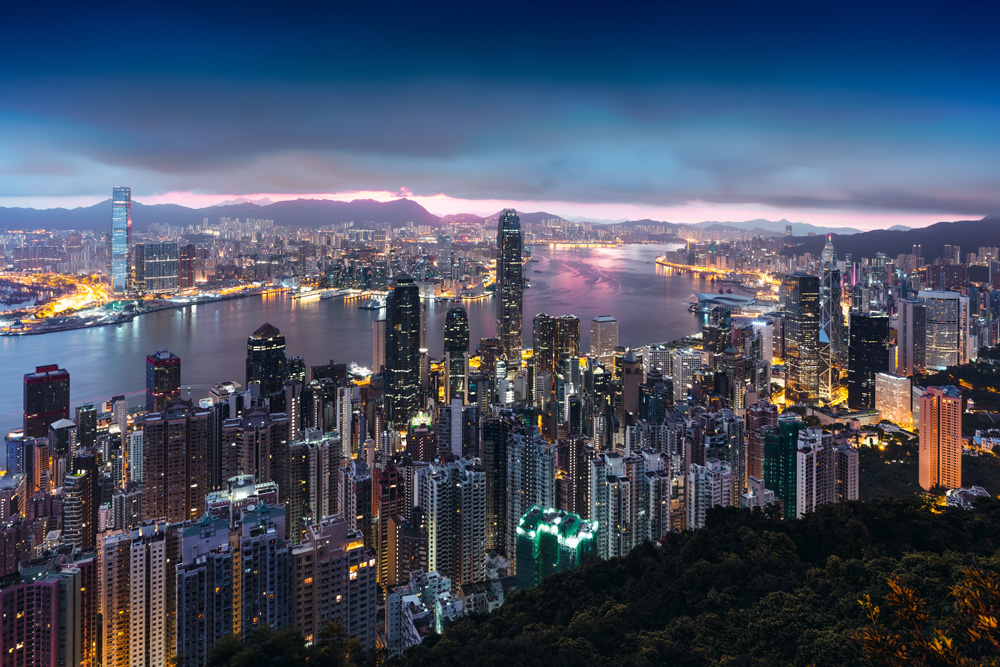
When you head on an Asian vacation, you want to have unforgettable experiences and see sights that cannot possibly be captured by images you see on the internet. If you head to these landmarks in Cambodia, Japan, the Philippines, Vietnam, Tibet, or Hong Kong, you can be sure that you’ll see at least one sight that takes your breath away.
Get more travel inspiration by email.
Subscribe
0 Comments

Get the latest travel trends & hear about the best deals on vacations around the world.
If you’re a Globetrotter, these are the newsletters for you!

